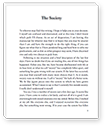Essay Instructions: Below is a copy of the report, suggested bibliography and working title I handed in as an approved structure, please work as closely to this as possible. Use any of Oscar wilde's writings.
Referencing in British Standard Numeric please...
Oscar Wilde, the 56;conformist rebel57;: the extent to which his work contains an inherent contradiction, pointing out the folly of his contemporary society and expressing values contrary to the social norm or expectation, whilst being published, performed and appreciated within that society.
Summary of Dissertation Scope:
The dissertation will discuss the central image of Wilde as a figure of contradiction and paradox. What reading of many biographies of Wilde57;s life and critiques of his work has gleaned, is that the reality of his image is one of inconsistent value. 56;Wilde blurs the edges and hides behind a non-alignment with his own utterances.57; Through examination of the social and moral standards of the time in which he was writing, his writing style and strong philosophical element to his work, and his dramatic personal life, I will attempt to highlight many of the contradictions between both his life and his work, his life and his society, and most importantly, his work and his society.
Chapter: 56;Elitist, classist, sexist, racist 51; A bigot condemning bigotry?57;
I propose to focus one chapter on Wilde57;s inherent hypocrisy in relation to the values of the society in which he lived, by discussing the probability of his bigotry in relation to certain areas of prejudice which did and did not relate to his lifestyle. The title of the chapter is posed in the form of a question as I plan to present arguments both for and against this theory (as is the way with contradicting evidence). There are elements of his work which particularly relate to the discussion of 56;elitism57;, both in the sense of basic snobbery and classism, and also to a deeper extent in relation to an appreciation of art and attitudes to the ability for learning and intellect. Similarly, the attitudes to women is something that is given less weight in the vast body of work on Wilde, mainly because his homosexuality was a such a defining characteristic in his relationship with society. However, the sexist values bestowed on women by the society of the period, are casually reflected in his work and in his direct discussion of women goes so far as to highlight the sexism of their lower gender status without the apparent irony which would induce his contemporary audience to think twice. A modern reading of texts such as The Picture of Dorian Gray and An Ideal Husband offer up much interesting material on Wilde57;s philosophies surrounding general Elitism and the place of the 56;fairer sex57;.
Chapter: 56;Vanity and social validation 51; biting the hand that feeds him?57;
60;There is only one thing in the world worse than being talked about, and that is not being talked about.61;
Another chapter will focus on the importance of the ideals of beauty, both in art and of the human form. It will be important here to talk about physical beauty and how a preoccupation with it is a highly influencing factor on Wilde57;s personality and possible feelings of inadequacy or compensation. There is an extent to which ideas of 56;age-ism57; and the elitism of the beautiful will link in with ideas from the previous chapter. Additionally, as a wider link to the beauty of art, the chapter will associate his role as artist with his own ego and how an appreciation of his work fuelled such. The most effective work in which to exemplify a discussion of these points will be The Picture of Dorian Gray.
Chapter: 56;The spectrum of human morality57;.
60;Sin is the only real colour-element left in modern life.61;
Given that Wilde is hailed as a great philosopher, the most important issue may be his general attitudes to morality. Although often defying the conventions of stock values of the contemporary Christian morality, it is suggested that the alternative moral viewpoints expressed in some of his work are the very element which draws (and drew a contemporary audience) into the escapist aspect of his writing. The irony however, and overriding contradiction of his life, is that what was appreciated about identification or empathy with characters of low moral fibre and a pleasure seeking ideal within his work, was repellent to his contemporaries when tied in with his personal life. The main methods of discussion here will be in relation to characterisation of figures of his literature like Lord Herny Wotton (The Picture of Dorian Gray), and Algernon 56;Algie57; Moncrieff (The Importance of Being Ernest), including some general theory on the attraction of evil or shady characters and the attractions of escapism in literature; contrasted with the scandals and social downfall of his own life, particularly surrounding his trials and jail sentence.
BIBLIOGRAPHY
Wilde, O. Holland, V. (ed.) The Complete Illustrated Works. London: Bounty Books. 1986.
Raby, P. (ed.) The Cambridge Companion to Oscar Wilde. Cambridge: Cambridge University Press. 1997.
Shewan, R. Oscar Wilde: Art and Egotism. London & Basingstoke: Macmillan Press. 1977.
Nicholls, M. The Importance of Being Oscar. London: Robson Books. 1980.
Ojala, A. Astheticism and Oscar Wilde: Part II, Literary Style. Helsinki. 1955.
Varty, A. A Preface to Oscar Wilde. New York: Longman. 1998.
Warwick, A. Oscar Wilde. Devon: Northcote House Publishers. 2007.
McKenna, N. The Secret Life of Oscar Wilde. London: Arrow Books Ltd. 2004.
Ellmann, R. Oscar Wilde. London: Penguin Books. 1988.
Harris, F. Oscar Wilde: His Life and Confessions. London: Wordsworth Editions. 1938.
Holland, M. (ed.) Oscar Wilde: A Life in Letters. New York: Fourth Estate. (2003).
Clark Amor, A. Mrs. Oscar Wilde: A Woman of Some Importance. Sidgwick & Jackson. 1983.
Foldy, M.S. The Trials of Oscar Wilde: Deviance, Morality and Late-Victorian Society. New Haven: Yale University Press. 1997.
Nunokawa, J. (1996) 56;The Importance of Being Bored: the dividends of ennui in The Picture of Dorian Gray57;. Studies in the Novel. Vol. 28. Questia [Online]. Avaliable at: www.questia.com. (Accessed: 23 Nov 2007).
Lesjak, C. 56;Utopia, Use and the Everyday: Oscar Wilde and a New Economy of Pleasure57;. ELH, Vol. 67, No. 1. (Spring 2000). Pp. 17951;204. JSTOR [Online] Avaliable at: http://wf2dnvr11.webfeat.org/. (Accessed: 24 Nov 2007).
Adut, A. 56;A Theory of Scandal: Victorians, Homosexuality and the Fall of Oscar Wilde57;. The American Journal of Sociology, Vol. 111, No. 1. (July 2005), pp.213-248. JSTOR [Online] Avaliable at: http://wf2dnvr11.webfeat.org/ (Accessed: 24 Nov 2007).
Stetz, M. D. 56;The Bi-Social Oscar Wilde and 60;Modern61; Women57;. Nineteenth Century Literature. 2001. JSTOR [Online] Avaliable at: http://wf2dnvr11.webfeat.org/ (Accessed: 24 Nov 2007).


